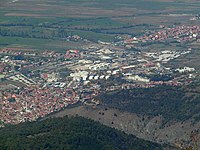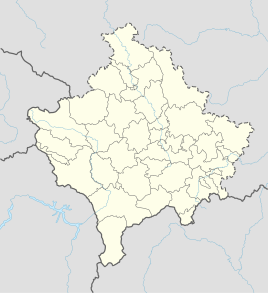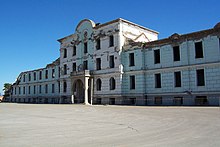Prizren Camp
|
|
|||
|---|---|---|---|

The Prizren camp taken from the summit of Cviljen, October 2001. |
|||
| country | Kosovo | ||
| local community | Prizren | ||
| Coordinates : | 42 ° 13 ' N , 20 ° 45' E | ||
| Stationed troops | |||
| Unity of the security forces of Kosovo |
|
||
| Formerly stationed units | |||
| German shares in KFOR Austrian shares in KFOR Swiss shares in KFOR Bulgarian shares in KFOR |
|
||
|
Location of the Prizren field camp in Kosovo |
|||
The Prizren field camp was a military base near Prizren in Kosovo operated by the German Bundeswehr from 1999 to 2018 as part of the KFOR mission . It was the headquarters of the German troop contingent (GECON) and, from 2001 to 2011, it was also the seat of the staff for the southern Kosovo area, which, with a few exceptions, was under the authority of a German brigadier general. In addition to the German troop presence, contingents of the Austrian Armed Forces (AUCON), the Swiss Army ( Swisscoy ) and the Bulgarian Army (BULCON) were temporarily stationed here.
location
The encampment was moved, partially using older properties on the site of the former Ramiz Sadiku barracks of the Yugoslav People's Army in Prizren. It was located on the northeastern outskirts of the city, directly on the M-25 road leading to Suhareka , surrounded by the Korilla district in the southwest and the suburb of Lubizhda in the northeast. It leaned against the northern slope of the Kosovar lake highlands "Maja e Liqenit". Looking over Korilla, the fortress of Prizren was within sight .
prehistory
The history of the military presence in Prizren began in 1906 when the Ottoman army stationed a regiment here to control the Albanian and Serbian local population . Only six years later in October 1912 Prizren was conquered by Serbia in the first Balkan War and the former Ottoman camp now became the site of a Serbian garrison . During the First World War , a unit of the Austro-Hungarian army was stationed here from November 1915 until, after its withdrawal in December 1918, the Serbian army was able to regain control of Prizren. In the interwar years, the barracks , in which the Yugoslav army was quartered from 1929, was expanded. Among other things, the staff building, which was painted blue, was erected during this time, which the Germans later called either the “Blue Residence”, “Blue Palace” or “Blue Building”. After the Balkans were conquered by German and Italian troops in World War II in 1941, most of Kosovo was attached to the Greater Albanian state associated with Italy , and an Italian occupation force was stationed in Prizren. After the breakup of the German-Italian alliance, the city was occupied by the German Wehrmacht in July 1943 and the SS division "Skanderbeg" moved into the barracks as their headquarters in February 1944 . On November 17, 1944, Prizren was liberated by partisan units of the Communist National Liberation Army of Albania.
In July 1945, the now communist Albania accepted the restoration of its original borders and with it the return of Kosovo to the Yugoslav union of states. Prizren thus became a location of the People's Army of Yugoslavia (VJ). The barracks are now named after the Kosovar Albanian resistance fighter Ramiz Sadiku , who was a member of Marshal Tito's communist partisans and who was executed in 1943 after his capture by the Italian army. By the middle of the last decade of the 20th century, the barracks had reached their greatest extent with about 46 hectares and also extended to a smaller area on the opposite side of the M-25, which was later referred to as "Lager Nord". In addition to the office building they had at least three more, built of red brick company buildings where mainly mobile infantry - and engineer units were quartered. There was also a troop kitchen and some smaller storage and maintenance buildings. With the exception of a ring road leading up to the company buildings and the troop kitchen and down from the headquarters building to the M-25, the barracks had no other paved roads.
During the Kosovo war in 1999 , the barracks was a target of NATO alliance air strikes and was hit several times by bombs and cruise missiles that damaged or completely destroyed all permanent buildings. At the same time as the German KFOR troops under Brigadier General Fritz von Korff marched into Prizren on June 13, 1999, the barracks were evacuated by the withdrawing Yugoslav army in accordance with the provisions of the Kumanovo Agreement .
Camp "VJ barracks"
The Prizren barracks was already intended as the headquarters of the German area of responsibility of the Multinational Brigade South (MNB-S) during the planning phase of the KFOR mission, but the facility first had to be cleared of the ordnance left behind after the bombing and damaged structural properties are being repaired. The MNB-S staff therefore initially moved into a temporary location in the halls of the PROGRES textile factory in the industrial park on the western edge of the city. It was only after the repair work was completed that the staff was able to move to the barracks in the spring of 2001, which in the unofficial jargon of the German soldiers continued to be referred to as "VJ barracks". Two of the three old company buildings had been renovated for further use. In one, now known as the "Red Staff", the offices of the brigade staff and in those of the staff of the telecommunications battalion and the camp commandant's offices were set up. In front of the latter, an honor grove for the Bundeswehr was created. The ruins of the third company building, on the other hand, were completely demolished in order to replace it with a new, lightweight building that was occupied by the staff of the reinforced engineer battalion. The old Yugoslav staff building, the “Blue Residence”, remained as a war relic now as a striking ruin, the forecourt of which has since been used as a parade room for battalions. The reinforced concrete skeleton of the old troop kitchen, located immediately behind the brigade staff, was also initially left standing and was only removed at a later point in time. In the low-rise building of a former warehouse opposite the “Blue Residence”, the telecommunication center including the satellite communication offices, material distribution and crypto management was set up. At the foot of the slope along the camp fence running along the M-25, the field hospital was initially located in tents and containers. In addition to two warehouse entrances, there were also the helicopter landing pads along the road, as well as the petrol station and some repair halls. Above the landing areas was the sports field, which was primarily used as a parking space for material and vehicles. The north-eastern storage area served as a storage area for the military vehicle fleet. Initially, tents and living containers served as crew and company quarters; the soldiers' mess was set up in a tent for several years.
The military presence of the German Armed Forces in Prizren was expanded from 2000 by a second field camp set up on the northern edge of the city, which was called the "Airfield". This warehouse mainly housed the halls of the repair units for large military equipment and the depot halls of the logistics units. The helicopters of the mixed army aviation division had been stationed since autumn 1999 on the tarmac of a former agricultural airfield near Topliçan near Suhareka. The editorial staff of the military newspaper “Maz & More” was also housed here. Both camps were dismantled by August 2011. In addition to these camps, the Bundeswehr operated other temporary outposts in the early years of the KFOR mission, especially in the Sharr mountain region with command posts in Srecka and Restelica to secure the border with North Macedonia and Albania , as well as the field camp "Phönix" near Rahovec and the "Morina" camp on the Kosovar-Albanian border. An electronic warfare listening post was operated on the summit of Mount Cviljen rising above the camp .
The task force TF-PRIZREN had set up its command post in the VJ barracks . Its priorities included the military security of the urban area as well as the security of the border with North Macedonia along the R-115 road in the mountains south of the city . For this purpose, advanced observation posts were moved to the castle hill and in the city center around the traffic junction of the “white house”. The task also included securing religious and cultural centers of the Serbian Orthodox Church such as the Church of the Redeemer , St. George's Cathedral and the Archangel's Monastery , but the guards set up in front of these buildings were withdrawn during the riots in 2004 .
In some cases with the cooperation of Kosovar employees, several care facilities were operated in the field camp, which were run by the various units. The tank grenadiers maintained the “Green Villa”, the paramedics the “San Shine Bar”, the reconnaissance men the “Swamp” and the pioneers the “Keiler”. The largest care facility was operated by the Fernmelder with the “Millennium Bar” built over the ruins of the troop kitchen, into which a troop cinema, a fitness tent and an internet café were integrated. Several buildings of a so-called local village were grouped around them, in which souvenirs, textiles and other necessities could be bought. Above this area, the camp was closed off by the quarters and offices of the civil-military cooperation (CIMIC) on its highest hillside . The officer corps of the brigade staff had its own recreation room in the “Wolfs Revier” hut, which is located next to the telecommunications center. An ecumenical field chapel was built in a small wooded section of the camp below the “Blue Residence” , which was joined by the facilities of the “Oase” jointly operated by the EAS and KAS , the sutler and the field post .
In the years after 2001, the field camp was continuously expanded. In particular, the temporary tent and container dwellings were replaced by permanent buildings and the unpaved roads and paths were paved. The tents and containers of the field hospital were also replaced by a permanent building, just as the troop kitchen was expanded into an open plan kitchen in 2009 with a two-story building below the telecommunications staff. A gym, a running track, a tennis and a volleyball court were built for sporting activities. The ruins of the “Blue Residence” were cleared of remaining ordnance in late 2013 and completely removed.
The expansion of the camp was accompanied by a gradual reduction in the troop presence. Especially after the dissolution of the control rooms and the centralization of the KFOR command structure with the "Film City" headquarters in Pristina in January 2011, the location in Prizren increasingly lost its military importance. While more than 6000 soldiers were stationed here at the beginning of the KFOR mission, there were a little more than 200 in 2018. In that year the military presence of the German troops in Prizren ended with the ceremonial handover of the field camp to the Kosovar civil authorities with a Handover appeal in the presence of Kosovar President Hashim Thaçi and German Ambassador Christian Heldt on October 4, 2018 in the old town of Prizren. On December 20, 2018, the federal service flag was overtaken by a detachment in front of the former red headquarters building .
Current usage
Since the withdrawal of the KFOR troops, the area of the former field camp has been developed for the establishment of an innovation and training center. The target group are German and Kosovar companies from the fields of information technology , agriculture and food as well as the creative industries. The innovation and training park (ITP) should also serve and be able to be used for vocational training. GIZ is in charge of setting up and organizing the park . In the ITP, for example, the State of the Map SEE 2019 , the meeting of the southeast European community of OpenStreetMap , took place in October 2019 .
The military tradition of the location was also continued. Since then, a unit of the Kosovar Security Forces (FSK) has been stationed in the smaller section of the barracks on the opposite side of the road from the M-25 ("Lager Nord") .
Web links
Press releases
- "Many more years to do". In: spiegel.de. Der Spiegel , April 25, 2001, accessed January 11, 2020 .
- The sad birthday of independent Kosovo. In: welt.de. Die Welt , February 17, 2011, accessed on January 11, 2020 .
- After almost 20 years, the Bundeswehr is closing its field camp in Prizren. In: fnp.de. Frankfurter Neue Presse , August 18, 2018, accessed on January 11, 2020 .
- The Bundeswehr closes its field camp in Kosovo after 20 years. In: aachener-nachrichten.de. Aachener Nachrichten , September 8, 2018, accessed on January 11, 2020 .
- A lot of trust - and two days of cowardice. In: faz.net. Frankfurter Allgemeine Zeitung , October 4, 2018, accessed on January 11, 2020 .
- The last Bundeswehr soldiers are leaving Kosovo after 20 years. In: augsburger-allgemeine.de. Augsburger Allgemeine , October 5, 2018, accessed on January 11, 2020 .
Individual evidence
- ↑ Who are we - The Innovation & Training Park (ITP) in Prizren. Retrieved April 9, 2020 .
- ↑ giz: Economic strengthening of the Prizren region. Retrieved April 9, 2020 .
- ^ State of the Map SEE - OSM and GIS Conference. Retrieved January 12, 2020 .


